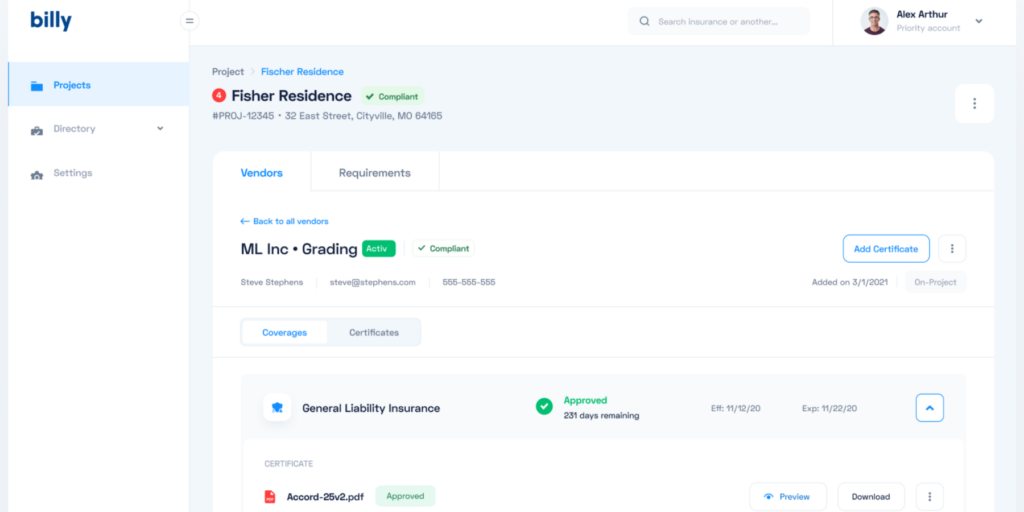As with anything in life, construction comes with some risk. However, with a cost of $15 million for non-compliance, these are expensive risks to take on. Remaining compliant and safe means adopting compliance management practices and avoiding the costly consequences that come from a lack thereof.
Compliance takes many forms, such as:
- Certificates of Insurance to verify subcontractor insurance coverage
- W-9 tax forms
- State and local business licenses and permits
- Equipment, safety, and training certifications
- Environment permits for waste disposal and clean air and water


That’s a lot to manage, and plenty of construction companies still manage compliance documents manually, wasting hours each week. To make matters worse, manual processes lead to inefficiencies and errors, which lead to a whole host of other potential legal issues.
We’ve partnered with the Billy Construction Compliance team to teach you about mitigating risk and remaining compliant.
What Is Construction Compliance?
Compliance is a collective effort to ensure you and your team have every document necessary for safe construction practices. These could be those aforementioned W-9s, business licenses, permits, and certifications needed to get the job done and protect you from non-compliance issues.
Building compliance doesn’t just cover safety; it also covers environmental expectations, legal due processes, and zoning authorizations. Here’s a quick look at some compliances construction managers must follow:
- OSHA: The Occupational Safety and Health Administration sets safety standards from PPE to restricted materials (Asbestos, lead paint, etc.) to ensure workers remain injury-free on the job site.
- EPA: The Environmental Protection Agency outlines proper material disposal, building location restrictions, clean air and water requirements, and hazardous material runoff management.
- Department of Labor: The DOL manages labor laws and wages so everyone gets paid fairly and on time.
- State and local jurisdictions: Building codes, inspections, and permits required by cities, counties, and states.
- Certificates of Insurance (COI): Construction insurance and bonding requirements to cover building materials, worksites, and workers.
The requirements vary depending on the construction type, project size, scope, employee counts, and locations. Failure to adhere to these compliances can result in severe consequences, such as fines upwards of $161,000, depending on the severity.
Fines are just the beginning. Consequences can escalate to criminal penalties or charges, project shutdowns, loss of contracts, or even human costs. At a minimum, some form of compliance management is necessary, but a comprehensive platform like Billy paired with construction cameras from TrueLook is a better option, especially as your operation grows.
Common Construction Compliance Issues
Compliance has several moving parts, each playing an integral role in keeping projects on schedule and budget while keeping everyone safe. Despite the best intentions of regulatory requirements, some issues still rear their ugly heads.
Document management
Document management is at the core of compliance since investors and government entities want to see permits, construction insurance, and licenses before you break ground. Late or missing compliance documents cause expensive project delays, meaning you must stay organized and up-to-date with Certificates of Insurance, safety certifications, licenses, vendor data, and training records for general contractors (GCs) and subcontractors.
Tools to manage and verify the proper documents make life easier by organizing, notifying, and recalling everything at the click of a button. As businesses modernize, removing manual and paper processes in favor of digital ones will elevate your document, permit, and license compliance.
Safety compliances
Keeping workers safe on the jobsite is a top priority. Adherence to OSHA safety regulations for equipment, PPE, training, and incident reporting is challenging for any safety officer. To ease their stress and prevent incidents, create a system for documenting safety audits, engage in toolbox talks, and enforce safety requirements regardless of the situation.
OSHA takes safety very seriously, and fines are steep for each violation. The worst-case scenario could involve someone getting seriously injured or losing their life—an avoidable tragedy when following proper safety and security measures.
Vendor and Subcontractor Management
You will inevitably encounter someone seeking employment with a stellar resume, only to uncover a massive gulf in actual skills. Those skills and compliance gaps lead to poor quality, unsafe, and out-of-code work.
Verify skills and training to avoid issues with vendors, contractors, and subcontractors. Also, remember to check insurance coverage, workers’ compensation policies, W-9s, and safety certifications. When working with multiple vendors, a digital tool takes some of the load off the back office staff.
Environmental Compliance
Environmental concerns and regulatory compliance are increasingly important to both the public and legislators. Compliance involves appropriately handling, storing, and disposing of hazardous materials and waste, maintaining air quality, and managing water runoff to prevent pollution.
The EPA has increasing control over construction projects, making compliance a growing concern for construction companies, general contractors, investors, and landowners. To avoid environmental hiccups, start surveys, permits, and licensing early in the vendor compliance process so you can address any concerns before breaking ground.
The Role of Technology in Solving Compliance Issues
Growing construction compliance concerns have business owners turning to technology to ease the pressure. Construction technology, especially construction cameras and compliance platforms, supports overall compliance efforts, allowing you to keep documents in order and keep a literal eye on your jobsites.
In fact, technology is so powerful for modern construction companies that their usage can even lead to lower insurance rates. Many businesses are now deploying some of these tech systems:
- Live Camera Viewing for Visibility: Camera feeds offer a real-time view of your jobsite to ensure compliance with safety and operational regulations. You can watch these live camera feeds remotely. Additionally, you can use a construction camera to monitor the jobsite and prevent theft.
- Time-Lapse and Documentation for Proof of Compliance: Time-lapse videos and secure jobsite documentation serve as proof for regulatory inspections and audits. The ability to recall these time-lapse images and videos expedites inspections and supports insurance claims should something happen.
- Intelligent Security and Incident Tracking: Construction camera security features and incident tracking help mitigate risk and provide accurate records of safety-related incidents. Solutions like TrueLook’s TrueShield and TrueDeter extend security further with comprehensive setups designed to deter criminal activity.
- Compliance Platforms with Jobsite Technology: Combining camera systems with management platforms like Billy creates end-to-end compliance, protecting you, jobsites, and employees.
- Automated collection and verification of construction industry documents: Utilizing automated COI collection and data import methods saves time and effort, especially for multi-site companies. Automated messaging also eliminates manual correspondence and requests verification of certificates, licenses, and other compliance documents.

Vendor compliance management is an unavoidable part of business, but technology automates more and more of the administrative side. That automation keeps you compliant so you can focus on what’s most important—getting the job done.
Best Practices for Staying Compliant on the Jobsite
Establishing systems for compliance reduces headaches and the possibility of an incident. A handful of best practices support those systems, raise your standards, and improve reputations. Consider implementing habits in your routine:
- Regular Safety Audits: Conduct frequent audits by internal teams or third-party partners to ensure strict compliance with safety standards. Monthly, quarterly, and annual audits keep teams prepared for regulatory inspections.
- Proper Documentation: Centralize and digitize documentation to create a single source of truth for all compliance documents. Automation tools streamline data collection and verification, allowing you to establish a standardized procedure.
- Training and Continued Education: Require regular safety and compliance training courses, focused on building awareness of regulatory and procedural updates. These programs emphasize safety, keeping it at the top of everyone’s mind.
- Use of Compliance Technology: Utilize tools like the Billy Construction Compliance software and on-site tech like TrueLook for effective compliance management. Incorporating these tools in tandem reduces your risk while streamlining day-to-day administrative tasks.
Mitigating risk through these best practices reduces insurance costs and potential safety incidents while boosting compliance adherence. However, dedication to compliance on the jobsite depends on creating an environment that values safety and compliance.
Achieve Compliance Success with Billy and TrueLook
Staying compliant isn’t a recommendation, either. It’s a requirement. Failure to follow compliance expectations leads to financial fines, legal troubles, government action, delayed projects, or worse.
Modern technology provides a method to remain compliant while spending less time on those tasks each day. A construction compliance platform, like Billy, automates data entry, documentation, and back-office tasks.
Likewise, technology like cameras, time-lapse videos, and jobsite monitoring from TrueLook, allows you to keep tabs on compliance and theft prevention.

